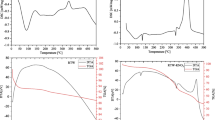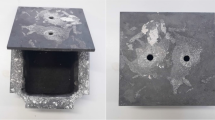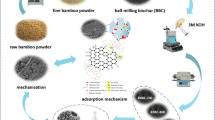Abstract
Boron doping of biochar leads to the formation of activated oxygen species and pores and defects in the carbon structure Therefore, boron-containing biochar was prepared by treating boric acid (H3BO3) solutions in different concentrations of hazelnut shells before pyrolysis. DSC results showed that treatment of biomass with solutions containing a low concentration (0.1 wt. %) of H3BO3 increased the degradation of cellulose and hemicellulose, but also increased char formation. However, treatment with solutions containing 2% and 5% H3BO3 increased biochar oxidation with the formation of boron oxide (B2O3). The FT-IR and XPS results showed the presence of B–B, B–O, and B–O–B in the H3BO3 treatment, which is due to the formation of B2O3. The examination of the proliferation of L929 mouse fibroblast cells in response to different concentrations of boron-containing biochars using the MTT assay revealed that biochar treated with 2% H3BO3 promoted cell growth (100.32 ± 1.93). However, above this concentration, the formation of polycrystalline B2O3 species exhibited an inhibitory effect on cell proliferation (81.98 ± 1.26) in the samples of H3BO3-doped biochar with 5% concentration. The results of the in vitro hemolysis tests for undoped biochar and high boron-containing (% 5) biochar sample showed mild hemolytic activity, with percentages of 2.46 ± 0.02 and 3.08 ± 0.04, respectively, according to the reported standards. Antimicrobial studies have shown that Candida albicans (a yeast, ATCC 10231) is more sensitive to H3BO3 than Staphylococcus aureus (Gram-positive bacteria, ATCC 29213). Boron-containing biochar can be used in a variety of applications, including biosensing, drug delivery, biological scaffolds, and biological imaging, as well as an adsorbent in the removal of pollutants and a catalyst in oxidation and electrochemical reactions.









Similar content being viewed by others
Data availability
Not applicable.
References
An N, Zhao M, Zheng X et al (2022) Synergistic oxytetracycline adsorption and peroxydisulfate-driven oxidation on nitrogen and sulfur co-doped porous carbon spheres. J Hazard Mater 424:127444. https://doi.org/10.1016/j.jhazmat.2021.127444
Wang W, Chen M (2022) Catalytic degradation of sulfamethoxazole by peroxymonosulfate activation system composed of nitrogen-doped biochar from pomelo peel: important roles of defects and nitrogen, and detoxification of intermediates. J Colloid Interface Sci 613:57–70. https://doi.org/10.1016/j.jcis.2022.01.006
Zheng R, Lin Q, Meng L et al (2022) Flexible phosphorus-doped activated carbon fiber paper in-situ loading of CuO for degradation of phenol. Sep Purif Technol 298:121619. https://doi.org/10.1016/j.seppur.2022.121619
Qu Z, Sun F, Gao J, Zhao G (2022) Activity origin of boron doped carbon cluster for thermal catalytic oxidation: coupling effects of dopants and edges. J Colloid Interface Sci 613:47–56. https://doi.org/10.1016/j.jcis.2022.01.017
Sawant SV, Patwardhan AW, Joshi JB, Dasgupta K (2022) Boron doped carbon nanotubes: synthesis, characterization and emerging applications–a review. Chem Eng J 427:131616. https://doi.org/10.1016/j.cej.2021.131616
Zhan H, Zhou Q, Li M et al (2022) Photocatalytic O2 activation and reactive oxygen species evolution by surface BN bond for organic pollutants degradation. Appl Catal B Environ 310:121329. https://doi.org/10.1016/j.apcatb.2022.121329
Duan X, O’Donnell K, Sun H et al (2015) Sulfur and nitrogen co-doped graphene for metal-free catalytic oxidation reactions. Small 11:3036–3044. https://doi.org/10.1002/smll.201403715
Lin Z, Wang X (2013) Nanostructure engineering and doping of conjugated carbon nitride semiconductors for hydrogen photosynthesis. Angew Chemie 125:1779–1782. https://doi.org/10.1002/ange.201209017
Zhang J, Koubaa A, Xing D et al (2020) Improving lignocellulose thermal stability by chemical modification with boric acid for incorporating into polyamide. Mater Des 191:108589. https://doi.org/10.1016/j.matdes.2020.108589
Hung C-M, Cheng J-W, Chen C-W et al (2023) Pyrolysis processes affecting polycyclic aromatic hydrocarbon profile of pineapple leaf biochar exemplified by atmosphere/temperature and heteroatom doping. Bioresour Technol 379:129047. https://doi.org/10.1016/j.biortech.2023.129047
Hung C-M, Chen C-W, Huang C-P et al (2022) Suppression of polycyclic aromatic hydrocarbon formation during pyrolytic production of lignin-based biochar via nitrogen and boron co-doping. Bioresour Technol 355:127246. https://doi.org/10.1016/j.biortech.2022.127246
Xin W, Song Y, Peng J et al (2017) Synthesis of biomass-derived mesoporous carbon with super adsorption performance by an aqueous cooperative assemble route. ACS Sustain Chem Eng 5:2312–2319. https://doi.org/10.1021/acssuschemeng.6b02637
Tian Z, Zhang Q, Thomsen L et al (2022) Constructing interfacial boron-nitrogen moieties in turbostratic carbon for electrochemical hydrogen peroxide production. Angew Chemie 134:e202206915. https://doi.org/10.1002/ange.202206915
Zhang J, Geng W, Shi L et al (2022) One–pot synthesis of boron and nitrogen co–doped nanocarbons for efficient catalytic reduction of nitrophenols. Chem Eng J 439:135733. https://doi.org/10.1016/j.cej.2022.135733
Wang Q, Li J, Winandy JE (2004) Chemical mechanism of fire retardance of boric acid on wood. Wood Sci Technol 38:375–389. https://doi.org/10.1007/s00226-004-0246-4
Cheng X, Wang B (2017) Yield, composition, and property of biochar obtained from the two-step pyrolysis of rice husk impregnated with boric acid. Energies 10:1814. https://doi.org/10.3390/en10111814
Zhang J, Koubaa A, Xing D et al (2020) Conversion of lignocellulose into biochar and furfural through boron complexation and esterification reactions. Bioresour Technol 312:123586. https://doi.org/10.1016/j.biortech.2020.123586
Zhang F, Miao J, Liu W et al (2019) Heteroatom embedded graphene-like structure anchored on porous biochar as efficient metal-free catalyst for ORR. Int J Hydrogen Energy 44:30986–30998. https://doi.org/10.1016/J.IJHYDENE.2019.09.239
Liu B, Guo W, Wang H et al (2020) B-doped graphitic porous biochar with enhanced surface affinity and electron transfer for efficient peroxydisulfate activation. Chem Eng J 396:125119. https://doi.org/10.1016/j.cej.2020.125119
Hung C-M, Chen C-W, Huang C-P, Dong C-D (2022) Metal-free single heteroatom (N, O, and B)-doped coconut-shell biochar for enhancing the degradation of sulfathiazole antibiotics by peroxymonosulfate and its effects on bacterial community dynamics. Environ Pollut 311:119984. https://doi.org/10.1016/j.envpol.2022.119984
Hung C-M, Chen C-W, Huang C-P, Dong C-D (2023) Nitrogen and boron co-doped lignin biochar for enhancing calcium peroxide activation toward organic micropollutants decontamination in waste activated sludge and related microbial structure dynamics. Bioresour Technol 372:128673. https://doi.org/10.1016/j.biortech.2023.128673
Sigmund G, Huber D, Bucheli TD et al (2017) Cytotoxicity of biochar: a workplace safety concern? Environ Sci Technol Lett 4:362–366. https://doi.org/10.1021/acs.estlett.7b00267
Öksüz KE, Özkaya NK, İnan ZDŞ, Özer A (2021) Novel natural spider silk embedded electrospun nanofiber mats for wound healing. Mater Today Commun 26:101942. https://doi.org/10.1016/j.mtcomm.2020.101942
Alexandre N, Ribeiro J, Gärtner A et al (2014) Biocompatibility and hemocompatibility of polyvinyl alcohol hydrogel used for vascular grafting—in vitro and in vivo studies. J Biomed Mater Res Part A 102:4262–4275. https://doi.org/10.1002/jbm.a.35098
Wang C, Wang S, Li K et al (2014) Preparation of laponite bioceramics for potential bone tissue engineering applications. PLoS ONE 9:e99585. https://doi.org/10.1371/journal.pone.0099585
Ma Z, Bai J, Wang Y, Jiang X (2014) Impact of shape and pore size of mesoporous silica nanoparticles on serum protein adsorption and RBCs hemolysis. ACS Appl Mater Interfaces 6:2431–2438. https://doi.org/10.1021/am404860q
Gao L, Chen J, Feng W et al (2020) A multifunctional shape-adaptive and biodegradable hydrogel with hemorrhage control and broad-spectrum antimicrobial activity for wound healing. Biomater Sci 8:6930–6945. https://doi.org/10.1039/D0BM00800A
Singh S, Bhushan S, Das A et al (2023) Surgical cotton microfibers loaded with nanoceria: a new platform for bone tissue engineering. Ceram Int 49:1114–1127. https://doi.org/10.1016/j.ceramint.2022.09.087
Cao X, Zhong L, Peng X et al (2014) Comparative study of the pyrolysis of lignocellulose and its major components: characterization and overall distribution of their biochars and volatiles. Bioresour Technol 155:21–27. https://doi.org/10.1016/J.BIORTECH.2013.12.006
Yang H, Yan R, Chen H et al (2007) Characteristics of hemicellulose, cellulose and lignin pyrolysis. Fuel 86:1781–1788. https://doi.org/10.1016/j.fuel.2006.12.013
Grigorovskaya VA, Shashkin DP, Zapadinskii BI (2009) Low-temperature transformations of orthoboric acid. Russ J Phys Chem B 3:656–660. https://doi.org/10.1134/S199079310904023X
Sevim F, Demir F, Bilen M, Okur H (2006) Kinetic analysis of thermal decomposition of boric acid from thermogravimetric data. Korean J Chem Eng 23:736–740. https://doi.org/10.1007/BF02705920
Rotaru A (2017) Thermal and kinetic study of hexagonal boric acid versus triclinic boric acid in air flow. J Therm Anal Calorim 127:755–763. https://doi.org/10.1007/s10973-016-5583-7
Huber C, Jahromy SS, Birkelbach F et al (2020) The multistep decomposition of boric acid. Energy Sci Eng 8:1650–1666. https://doi.org/10.1002/ese3.622
Zhang J, Koubaa A, Xing D et al (2020) Conversion of lignocellulose into biochar and furfural through boron complexation and esterification reactions. Bioresour Technol 312:123586. https://doi.org/10.1016/J.BIORTECH.2020.123586
Ahn Y, Hu DH, Hong JH et al (2012) Effect of co-solvent on the spinnability and properties of electrospun cellulose nanofiber. Carbohydr Polym 89:340–345. https://doi.org/10.1016/J.CARBPOL.2012.03.006
Thommes M, Kaneko K, Neimark AV et al (2015) Physisorption of gases, with special reference to the evaluation of surface area and pore size distribution (IUPAC Technical Report). Pure Appl Chem 87:1051–1069. https://doi.org/10.1515/pac-2014-1117
Watanabe H, Shimomura K, Okazaki K (2013) Effect of high CO2 concentration on char formation through mineral reaction during biomass pyrolysis. Proc Combust Inst 34:2339–2345. https://doi.org/10.1016/J.PROCI.2012.07.048
Parshetti GK, Hoekman SK, Balasubramanian R (2013) Chemical, structural and combustion characteristics of carbonaceous products obtained by hydrothermal carbonization of palm empty fruit bunches. Bioresour Technol 135:683–689. https://doi.org/10.1016/j.biortech.2012.09.042
Schwanninger M, Rodrigues JC, Pereira H, Hinterstoisser B (2004) Effects of short-time vibratory ball milling on the shape of FT-IR spectra of wood and cellulose. Vib Spectrosc 36:23–40. https://doi.org/10.1016/J.VIBSPEC.2004.02.003
Mayakaduwa SS, Vithanage M, Karunarathna A et al (2016) Interface interactions between insecticide carbofuran and tea waste biochars produced at different pyrolysis temperatures. Chem Speciat Bioavailab 28:110–118. https://doi.org/10.1080/09542299.2016.1198928
Chen Z, Chen B, Chiou CT (2012) Fast and slow rates of naphthalene sorption to biochars produced at different temperatures. Environ Sci Technol 46:11104–11111. https://doi.org/10.1021/es302345e
Chen B, Johnson EJ, Chefetz B et al (2005) Sorption of polar and nonpolar aromatic organic contaminants by plant cuticular materials: role of polarity and accessibility. Environ Sci Technol 39:6138–6146. https://doi.org/10.1021/es050622q
Ocampo-Perez R, Padilla-Ortega E, Medellin-Castillo NA et al (2019) Synthesis of biochar from chili seeds and its application to remove ibuprofen from water. Equilibrium and 3D modeling. Sci Total Environ 655:1397–1408. https://doi.org/10.1016/J.SCITOTENV.2018.11.283
Xiao X, Chen B, Zhu L (2014) Transformation, morphology, and dissolution of silicon and carbon in rice straw-derived biochars under different pyrolytic temperatures. Environ Sci & Technol 48:3411–3419. https://doi.org/10.1021/es405676h
Asadinezhad A, Novák I, Lehocký M et al (2010) Polysaccharides coatings on medical-grade PVC: a probe into surface characteristics and the extent of bacterial adhesion. Molecules 15:1007–1027. https://doi.org/10.3390/molecules15021007
Usevičiūtė L, Baltrėnaitė‐gedienė E, Feizienė D (2022) The combined effect of biochar and mineral fertilizer on triticale yield, soil properties under different tillage systems. Plants 11. https://doi.org/10.3390/plants11010111
Chen B, Zhou D, Zhu L (2008) Transitional adsorption and partition of nonpolar and polar aromatic contaminants by biochars of pine needles with different pyrolytic temperatures. Environ Sci Technol 42:5137–5143. https://doi.org/10.1021/es8002684
Fontana IB, Peterson M, Cechinel MAP (2018) Application of brewing waste as biosorbent for the removal of metallic ions present in groundwater and surface waters from coal regions. J Environ Chem Eng 6:660–670. https://doi.org/10.1016/J.JECE.2018.01.005
Kumar A, Gupta V, Gaikwad KK (2021) Microfibrillated cellulose from pine cone: extraction, properties, and characterization. Biomass Convers Biorefinery. https://doi.org/10.1007/s13399-021-01794-2
Chen X, Duan X, Da OhW et al (2019) Insights into nitrogen and boron-co-doped graphene toward high-performance peroxymonosulfate activation: maneuverable N-B bonding configurations and oxidation pathways. Appl Catal B Environ 253:419–432. https://doi.org/10.1016/J.APCATB.2019.04.018
Wang F, Wang Y, Chen J et al (2021) Effect of cerium oxide on phase composition, structure, thermal stability and aqueous durability of sodium-iron-boron-phosphate based glasses. J Nucl Mater 556:153199. https://doi.org/10.1016/J.JNUCMAT.2021.153199
Wang J, Zhang P, Peng J et al (2023) Sulfur and nitrogen co-doped magnetic biochar coupled with hydroxylamine for high-efficiency of persulfate activation and mechanism study. Environ Res 216:114745. https://doi.org/10.1016/J.ENVRES.2022.114745
Suwattanamala A, Bandis N, Tedsree K, Issro C (2017) Synthesis, characterization and adsorption properties of Fe3O4 /MWCNT magnetic nanocomposites. Mater Today Proc 4:6567–6575. https://doi.org/10.1016/J.MATPR.2017.06.169
Ahmed MB, Zhou JL, Ngo HH et al (2016) Progress in the preparation and application of modified biochar for improved contaminant removal from water and wastewater. Bioresour Technol 214:836–851. https://doi.org/10.1016/J.BIORTECH.2016.05.057
Jia H, Sun J, Xie X et al (2019) Cicada slough-derived heteroatom incorporated porous carbon for supercapacitor: ultra-high gravimetric capacitance. Carbon N Y 143:309–317. https://doi.org/10.1016/j.carbon.2018.11.011
Liu N, Charrua AB, Weng CH et al (2015) Characterization of biochars derived from agriculture wastes and their adsorptive removal of atrazine from aqueous solution: a comparative study. Bioresour Technol 198:55–62. https://doi.org/10.1016/J.BIORTECH.2015.08.129
Le Y, Guan Y, Ma X, Zhang W (2023) Preparation and boron removal performance of glycidol modified PANI nanorods: An optimization study based on response surface methodology. Polymers 15(2):459. https://doi.org/10.3390/polym15020459
Zhao W, Ma W, Chen C et al (2004) Efficient degradation of toxic organic pollutants with Ni2O3/TiO2-x B x under visible irradiation. J Am Chem Soc 126:4782–4783. https://doi.org/10.1021/ja0396753
Liu G, Yin LC, Niu P et al (2013) Visible-light-responsive β-Rhombohedral boron photocatalysts. Angew Chemie - Int Ed 52:6242–6245. https://doi.org/10.1002/anie.201302238
BS EN ISO, British Standards (2009) Biological evaluation of medical devices. https://doi.org/10.3403/BSENISO10993
Pettinelli N, Rodriguez-Llamazares S, Bouza R et al (2020) Carrageenan-based physically crosslinked injectable hydrogel for wound healing and tissue repairing applications. Int J Pharm 589:119828. https://doi.org/10.1016/j.ijpharm.2020.119828
Hoppe A, Mouriño V, Boccaccini AR (2013) Therapeutic inorganic ions in bioactive glasses to enhance bone formation and beyond. Biomater Sci 1:254–256. https://doi.org/10.1039/c2bm00116k
Nzietchueng RM, Dousset B, Franck P et al (2002) Mechanisms implicated in the effects of boron on wound healing. J Trace Elem Med Biol 16:239–244. https://doi.org/10.1016/S0946-672X(02)80051-7
Demirci S, Doğan A, Aydın S et al (2016) Boron promotes streptozotocin-induced diabetic wound healing: roles in cell proliferation and migration, growth factor expression, and inflammation. Mol Cell Biochem 417:119–133. https://doi.org/10.1007/s11010-016-2719-9
Wu C, Chang J (2014) Multifunctional mesoporous bioactive glasses for effective delivery of therapeutic ions and drug/growth factors. J Control Release 193:282–295. https://doi.org/10.1016/j.jconrel.2014.04.026
Durand LAH, Vargas GE, Romero NM et al (2015) Angiogenic effects of ionic dissolution products released from a boron-doped 45S5 bioactive glass. J Mater Chem B 3:1142–1148. https://doi.org/10.1039/c4tb01840k
Penn SG, Hu H, Brown PH, Lebrilla CB (1997) Direct analysis of sugar alcohol borate complexes in plant extracts by matrix-assisted laser desorption/ionization Fourier transform mass spectrometry. Anal Chem 69:2471–2477. https://doi.org/10.1021/ac970101o
Nagai Y, Kobayashi K, Toi H, Aoyama Y (1993) Stabilization of sugar-boronic esters of indolylboronic acid in water via sugar–indole interaction: a notable selectivity in oligosaccharides. Bull Chem Soc Jpn 66:2965–2971. https://doi.org/10.1246/bcsj.66.2965
Zhao Y, Sun X, Zhang G et al (2011) Interaction of mesoporous silica nanoparticles with human red blood cell membranes: size and surface effects. ACS Nano 5:1366–1375. https://doi.org/10.1021/nn103077k
Manivasagam VK, Popat KC (2023) Improved hemocompatibility on superhemophobic micro–nano-structured titanium surfaces. Bioengineering 10:43. https://doi.org/10.3390/bioengineering10010043
Manivasagam VK, Sabino RM, Kantam P, Popat KC (2021) Surface modification strategies to improve titanium hemocompatibility: a comprehensive review. Mater Adv 2:5824–5842. https://doi.org/10.1039/d1ma00367d
Anjaneyulu U, Swaroop VK, Vijayalakshmi U (2016) Preparation and characterization of novel Ag doped hydroxyapatite–Fe 3 O 4–chitosan hybrid composites and in vitro biological evaluations for orthopaedic applications. RSC Adv 6:10997–11007. https://doi.org/10.1039/C5RA21479C
Fink K, Uchman M (2021) Boron cluster compounds as new chemical leads for antimicrobial therapy. Coord Chem Rev 431:213684. https://doi.org/10.1016/j.ccr.2020.213684
Yilmaz MT (2012) Minimum inhibitory and minimum bactericidal concentrations of boron compounds against several bacterial strains. Turkish J Med Sci 42:1423–1429. https://doi.org/10.3906/sag-1205-83
Orak F, Nazik H, Yalcinkaya KT et al (2022) Antifungal efficacy of pure boron on yeast and mold isolates causing superficial mycosis. J Pak Med Assoc 72:1330–1334. https://doi.org/10.47391/JPMA.2219
Moore JA, Committee ES (1997) An assessment of boric acid and borax using the IEHR evaluative process for assessing human developmental and reproductive toxicity of agents. Reprod Toxicol 11:123–160. https://doi.org/10.1016/S0890-6238(96)00204-3
Funding
Project M-795 of Sivas Cumhuriyet University- Scientific Research (CUBAP) fund provided funding for this work. Authors thank for XPS analysis to TENMAK (Turkish Energy, Nuclear and Mineral Research Agency).
Author information
Authors and Affiliations
Contributions
Ayten Ateş: conceptualization; investigation; methodology; writing original draft, review, and editing; supervision; funding acquisition. Burçak Aydemir: formal analysis, investigation, data curation. Kerim Emre Öksüz: formal analysis, methodology, writing original draft, review and editing.
Corresponding author
Ethics declarations
Ethical approval
Not applicable.
Competing interests
The authors declare no competing interests.
Additional information
Publisher's note
Springer Nature remains neutral with regard to jurisdictional claims in published maps and institutional affiliations.
Supplementary Information
Below is the link to the electronic supplementary material.
Rights and permissions
Springer Nature or its licensor (e.g. a society or other partner) holds exclusive rights to this article under a publishing agreement with the author(s) or other rightsholder(s); author self-archiving of the accepted manuscript version of this article is solely governed by the terms of such publishing agreement and applicable law.
About this article
Cite this article
Ateş, A., Aydemir, B. & Öksüz, K.E. Investigation of physicochemical and biological properties of boron-doped biochar. Biomass Conv. Bioref. (2023). https://doi.org/10.1007/s13399-023-04567-1
Received:
Revised:
Accepted:
Published:
DOI: https://doi.org/10.1007/s13399-023-04567-1




